Astroチュートリアルざっくり説明〜オフラインイベント資料〜
本スクラップについて
Astro公式チュートリアルの一部を、簡単にまとめてみました。
チュートリアル自体が意外と長くて、途中で力尽きちゃいました!!
レイアウトコンポーネントとか、コードフェンスの話とか入れれてないです!!
ごめんなさい!!笑
公式チュートリアルはこちら。ブログサイトの構築を行います。
出来上がったらこんな感じ!
チュートリアルをやり切ったら、こんな感じのサイトが出来上がります🎉
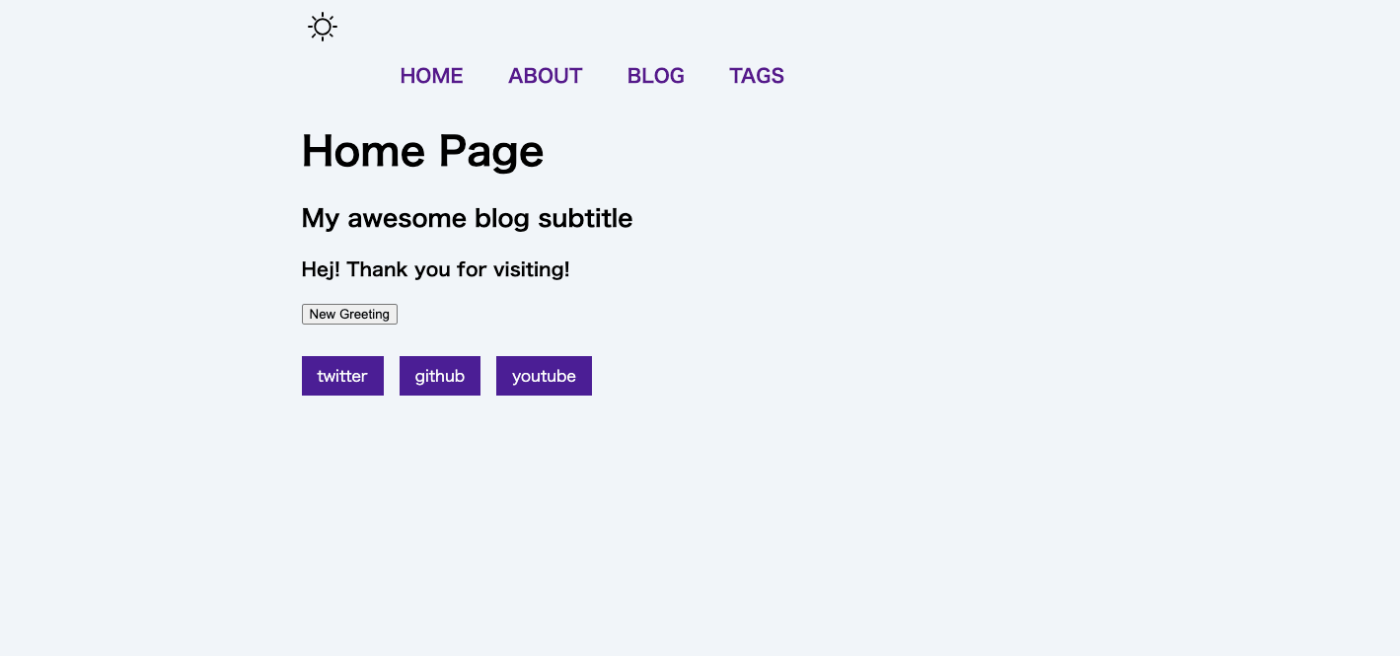
チュートリアルを進める準備
チュートリアルを進める前に、必要なものを準備しておきます。
必要なもの
- ターミナル
- Node.js(
v16.12.0以上) - エディタ(チュートリアルでは、VS Codeを使用。)
VS Codeの拡張機能があれば、便利です!
拡張機能のところで、Astroと入力したら出てきます。

Astroプロジェクトを作る
必要なものが揃ったので、Astroでプロジェクトを作ります。
以下のコマンドで、プロジェクトを作っていきます。
npmを使っていますが、yarnでもOK👍
npm create astro@latest
ディレクトリについてとか、色々聞かれるので、回答していきます。
全部回答したら、こんな感じになります。

サンプルファイルを入れておくかどうかやTypeScriptを使うかなどについて聞かれます!
サンプルファイルの有無については、最初に起動した時の画面表示に違いがありますが、チュートリアルを進めるのにそこまで大きく影響しないので、どちらを選んでも一応大丈夫です。が、どちらかと言えばサンプルファイル無しの方がおすすめです。
プロジェクトが作成できたら、ディレクトリを移動して、npm run devで起動します。
http://localhost:3000を開いてください。
起動したら、まだ何も手を加えていない状態なので、先ほどのサンプルファイルの有無の選択によって、画面表示が異なります。再度お伝えしておきますが、画面表示に違いはありますが、少し書き換えが必要なくらいで、問題なくチュートリアルを進められます。
【サンプルファイル無しを選択した場合】
背景色が白なので、わかりにくいですね〜笑

【サンプルファイル有りを選択した場合】
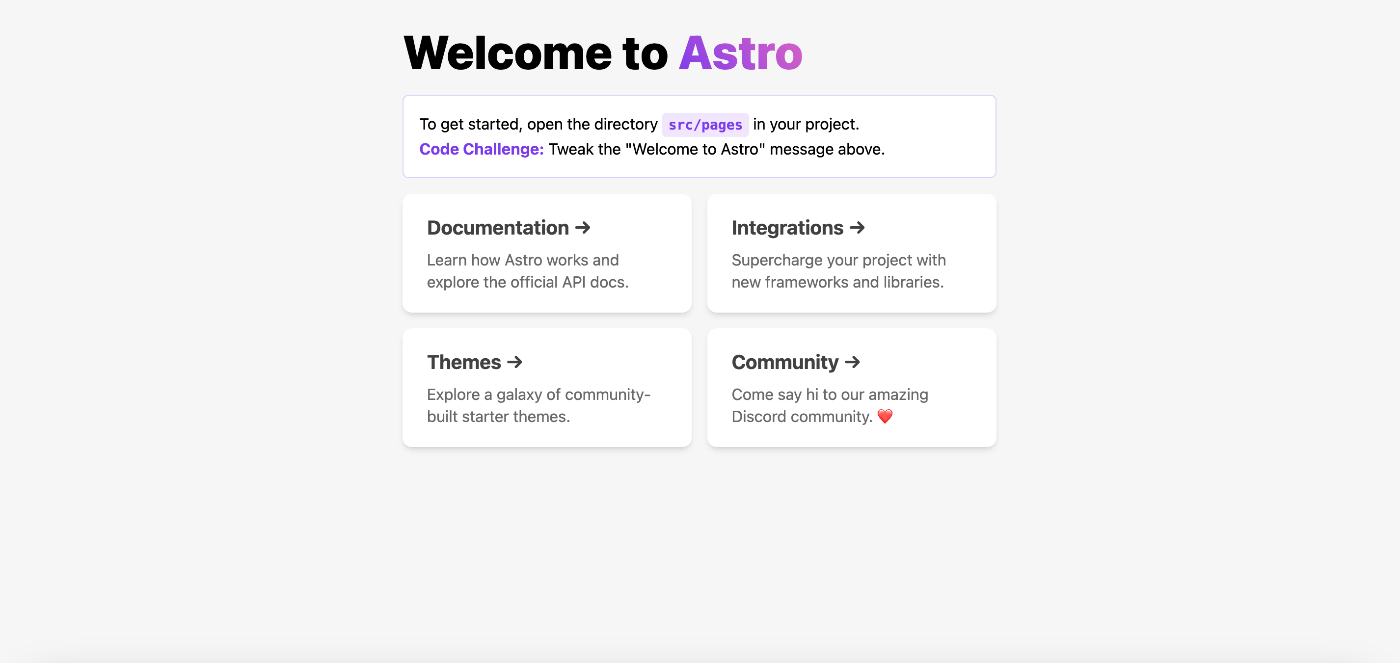
起動して画面表示を確認できたら、開発をスタートできます🎉
タイトルを変えてみる
ここからは、実際にAstroファイルを触っていきます。
単純にタイトル文字列を書き換えてみる
まずは、index.astroでタイトルを変えてみます。
Astroになっているところを、My Astro Siteに変えてみます。
<body>
- <h1>Astro</h1>
+ <h1>My Astro Site</h1>
</body>
画面ではこんな感じになります!

My Astro Siteになっています🎉
変数を使ってタイトルを指定することもできる
変数を使って、ページのタイトルを指定することもできます。
index.astroのコードフェンスにpageTitleを定義して、HTMLの中で変数展開して使います。
ここでは、タイトルをHome Pageにしています。
---
const pageTitle = 'Home Page';
---
<html lang='en'>
<head>
<meta charset='utf-8' />
<link rel='icon' type='image/svg+xml' href='/favicon.svg' />
<meta name='viewport' content='width=device-width' />
<meta name='generator' content={Astro.generator} />
<title>{pageTitle}</title>
</head>
<body>
<h1>{pageTitle}</h1>
</body>
</html>
HTML部分を見てみると、title要素とh1要素で変数展開を行なっています🎉
ページを作ってみる
Astroは、ファイルベースルーティングを採用しているので、src/pages/以下にファイルを作成することで、ルーティングできるようになります。
AboutページとBlogページを作るのであれば、about.astroとblog.astroをsrc/pages/に作ります。
これにより、/aboutと/blogにアクセスできるようになります。
Aboutページ
about.astroはこんな感じです。
---
---
<html lang='en'>
<head>
<meta charset='utf-8' />
<meta name='viewport' content='width=device-width' />
<title>Astro</title>
</head>
<body>
<a href='/'>Home</a>
<a href='/about/'>About</a>
<a href='/blog/'>Blog</a>
<h1>My Astro Site</h1>
<h1>About Me</h1>
<h2>... and my new Astro site!</h2>
<p>
I am working through Astro's introductory tutorial. This is the second
page on my website, and it's the first one I built myself!
</p>
<p>
This site will update as I complete more of the tutorial, so keep checking
back and see how my journey is going!
</p>
</body>
</html>
http://localhost:3000/about/にアクセスすると...
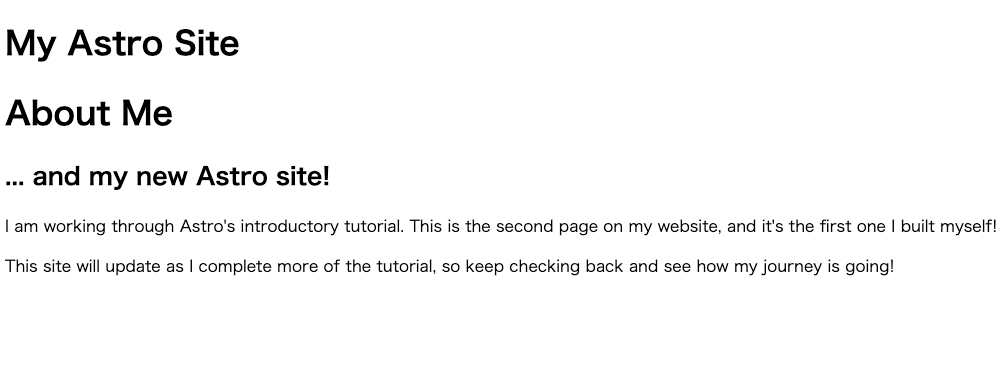
Aboutページが見れました🎉
Blogページ
blog.astroはこんな感じです。
---
---
<html lang='en'>
<head>
<meta charset='utf-8' />
<meta name='viewport' content='width=device-width' />
<title>Astro</title>
</head>
<body>
<a href='/'>Home</a>
<a href='/about/'>About</a>
<a href='/blog/'>Blog</a>
<h1>My Astro Learning Blog</h1>
<p>This is where I will post about my journey learning Astro.</p>
</body>
</html>
http://localhost:3000/blog/にアクセスすると...

Blogページが見れました🎉
ブログ記事を用意する
Blogページにアクセスできるようになったところで、ブログ記事と記事へのリンクを準備していきます。
記事をマークダウンで作成する
ブログ記事は、マークダウンで作成します。
src/pages/posts/ディレクトリを作ってその中に、post-1.mdというファイルを作ります。
マークダウンファイル(.md)を使います。
---
title: 'My First Blog Post'
pubDate: 2022-07-01
description: 'This is the first post of my new Astro blog.'
author: 'Astro Learner'
image:
url: 'https://docs.astro.build/assets/full-logo-light.png'
alt: 'The full Astro logo.'
tags: ["astro", "blogging", "learning in public"]
---
# My First Blog Post
Published on: 2022-07-01
Welcome to my _new blog_ about learning Astro! Here, I will share my learning journey as I build a new website.
## What I've accomplished
1. **Installing Astro**: First, I created a new Astro project and set up my online accounts.
2. **Making Pages**: I then learned how to make pages by creating new `.astro` files and placing them in the `src/pages/` folder.
3. **Making Blog Posts**: This is my first blog post! I now have Astro pages and Markdown posts!
## What's next
I will finish the Astro tutorial, and then keep adding more posts. Watch this space for more to come.
http://localhost:3000/posts/post-1にアクセスしてみると...

ブログ記事が見れました🎉
ブログ記事のリンクを作る
blog.astroに、先ほど作ったブログ記事のリンクを配置します。
ulタグを使って、記事をリスト表示できるようにしています。
<h1>My Astro Learning Blog</h1>
<p>This is where I will post about my journey learning Astro.</p>
<ul>
<li><a href="/posts/post-1/">Post 1</a></li>
</ul>
http://localhost:3000/blog/にアクセスすると...
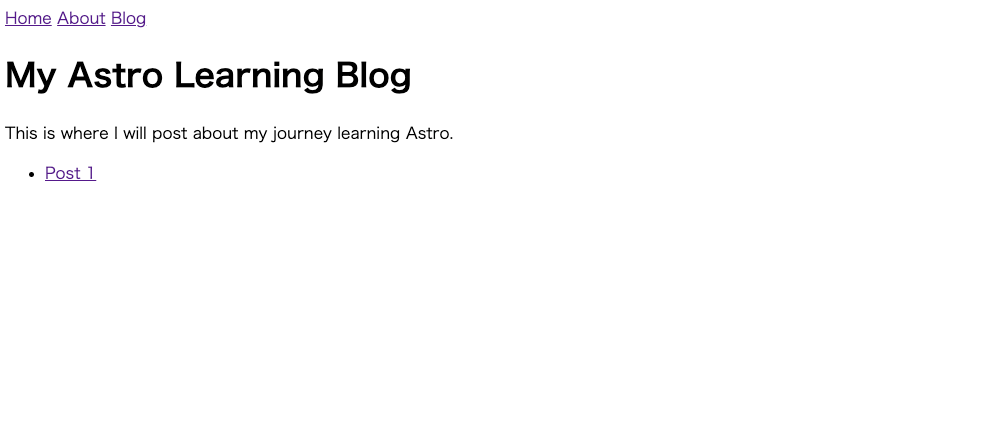
記事へのリンクができています🎉
もう少し記事を用意する & リンク配置
こんな感じで、post-2.mdとpost-3.mdを作成します。
---
title: My Second Blog Post
author: Astro Learner
description: "After learning some Astro, I couldn't stop!"
image:
url: "https://docs.astro.build/assets/arc.webp"
alt: "Thumbnail of Astro arcs,"
pubDate: 2022-07-08
tags: ["astro", "blogging", "learning in public", "successes"]
---
After a successful first week learning Astro, I decided to try some more. I wrote and imported a small component from memory!
---
title: My Third Blog Post
author: Astro Learner
description: "I had some challenges, but asking in the community really helped!"
image:
url: "https://docs.astro.build/assets/rays.webp"
alt: "Thumbnail of Astro rays."
pubDate: 2022-07-15
tags: ["astro", "learning in public", "setbacks", "community"]
---
It wasn't always smooth sailing, but I'm enjoying building with Astro. And, the [Discord community](https://astro.build/chat) is really friendly and helpful!
blog.astroに、リンクを追加します。
<head>
<meta charset="utf-8"/>
<meta name="viewport" content="width=device-width" />
<title>Astro</title>
</head>
<body>
<a href="/">Home</a>
<a href="/about/">About</a>
<a href="/blog/">Blog</a>
<h1>My Astro Learning Blog</h1>
<p>This is where I will post about my journey learning Astro.</p>
<ul>
<li><a href="/posts/post-1/">Post 1</a></li>
+ <li><a href="/posts/post-2/">Post 2</a></li>
+ <li><a href="/posts/post-3/">Post 3</a></li>
</ul>
</body>
スタイルの定義と適用
各ページのスタイル定義と適用
スタイルの定義は、styleタグを使うことができます。
about.astroで、以下のように、スタイルを定義します。
<style>
h1 {
color: purple;
font-size: 4rem;
}
</style>
<html lang='en'>
〜略〜
</html>
また、変数を利用することもできます。
about.astroのコードフェンスにて、次のように変数宣言します。
---
〜略〜
const skillColor = 'navy';
---
styleタグで変数を扱う場合、define:varsディレクティブを渡します。
<style define:vars={{ skillColor }}>
h1 {
color: purple;
font-size: 4rem;
}
+ .skill {
+ color: var(--skillColor);
+ font-weight: bold;
+ }
</style>
スタイルを適用したい要素にclassを渡すことで、適用することができます。
グローバルスタイルの定義と適用
グローバルスタイルを定義して適用することも可能です。
src/styles/ディレクトリを作成し、global.cssというCSSファイルを作成します。
html {
background-color: #f1f5f9;
font-family: sans-serif;
}
body {
margin: 0 auto;
width: 100%;
max-width: 80ch;
padding: 1rem;
line-height: 1.5;
}
* {
box-sizing: border-box;
}
h1 {
margin: 1rem 0;
font-size: 2.5rem;
}
このグローバルスタイルを、Aboutページに適用してみます。
about.astroのコードフェンスの中でimportします。
---
import '../styles/global.css';
〜略〜
---
個別のスタイルとグローバルスタイルを適用したAboutページはこんな感じです。

無事、スタイルが適用されています🎉
また、index.astroやblog.astroにも、グローバルスタイルをimportしておいて下さい。
コンポーネントを作る
続いて、コンポーネントを作っていきます。
Astroは、コンポーネントベースで開発を進めていきます。
src/components/ディレクトリを作ります。この中にコンポーネントを作っていきます。
ナビゲーション部分をコンポーネントにします。
componentsディレクトリに、Navigation.astroというファイルを作ります。
---
---
<a href='/'>Home</a>
<a href='/about/'>About</a>
<a href='/blog/'>Blog</a>
これで、Navigationコンポーネントができました🎉
index.astroにimportします。
---
import '../styles/global.css';
+ import Navigation from '../components/Navigation.astro';
---
そして、index.astroにて、importしたNavigationコンポーネントを使います。
- <a href="/">Home</a>
- <a href="/about/">About</a>
- <a href="/blog/">Blog</a>
+ <Navigation />
<h1>My Astro Site</h1>
このNavigationコンポーネントを、about.astroとblog.astroにも同じようにimportして使います。
コンポーネントでpropsを受け取りたい!
コンポーネントでpropsを受け取る方法を見ていきます。
Footerコンポーネントを用意する
とりあえず、Footerコンポーネントを用意します。
src/components/ディレクトリに、Footer.astroを作ります。
---
const platform = "github";
const username = "withastro";
---
<footer>
<p>Learn more about my projects on <a href={`https://www.${platform}.com/${username}`}>{platform}</a>!</p>
</footer>
Footerコンポーネントができました。
index.astro、about.astro、blog.astroにimportして使います。
例えば、index.astroだと以下のようになります。
---
import '../styles/global.css';
import Navigation from '../components/Navigation.astro';
+import Footer from '../components/Footer.astro';
---
<html lang='en'>
〜略〜
<body>
<Navigation />
<h1>My Astro Site</h1>
+ <Footer />
</body>
</html>
Socialコンポーネントを作る
次に、Social.astroファイルをcomponents/ディレクトリに作ります。
ソーシャルメディアのリンクのコンポーネントです。上のFooterコンポーネントで実装されているようなリンクを、Socialコンポーネントに切り出します。
---
const { platform, username } = Astro.props;
---
<a href={`https://www.${platform}.com/${username}`}>{platform}</a>
Socialコンポーネントができました。
このコンポーネントでは、propsを受け取っています。
Astro.propsで、componentに渡された値をpropsとして受け取っています。ここでは、platformとusernameを受け取っています。
---
const { platform, username } = Astro.props;
---
このSocialコンポーネントをFooterコンポーネントで使います。
---
-const platform = "github";
-const username = "withastro";
+import Social from './Social.astro';
---
<footer>
- <p>
- Learn more about my projects on <a href={`https://www.${platform}.com/${username}`}>{platform}
- </a>!
- </p>
+ <Social platform="twitter" username="astrodotbuild" />
+ <Social platform="github" username="withastro" />
+ <Social platform="youtube" username="astrodotbuild" />
</footer>
Socialコンポーネントに、platformとusernameをそれぞれ渡しています。
Socialコンポーネントでスタイルをあてたら、こんな感じになります。
http://localhost:3000/aboutで見てみると...
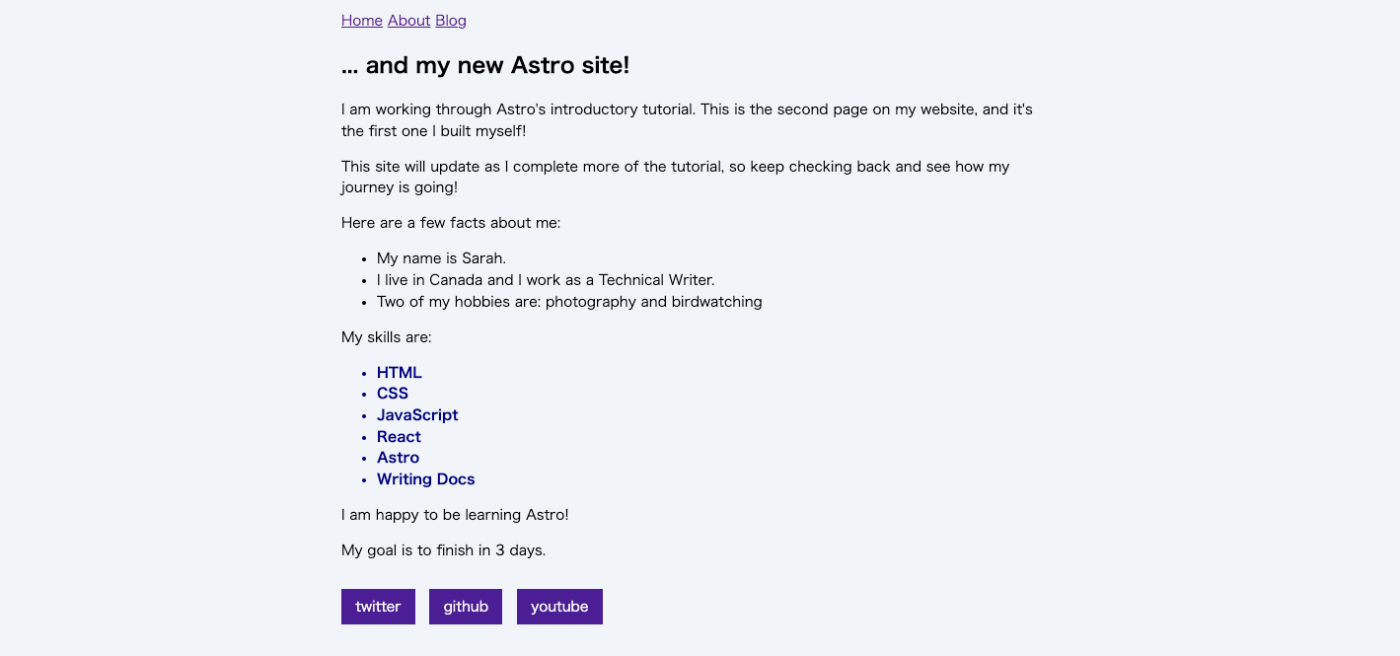
ソーシャルメディアのリンクが出来上がっています🎉
ほかのページでもFooterコンポーネントを使っているので、同じ見た目のリンクが配置されているかと思います。
おわりに
Astro公式チュートリアルの内容が割と濃くて、力尽きてしまいました...😭
レイアウトコンポーネントなどなど、説明することはもっとあるのですが、間に合わなかったです。ごめんなさい🙏
興味がある方は、公式チュートリアルにも是非、挑戦してみて下さい🔥